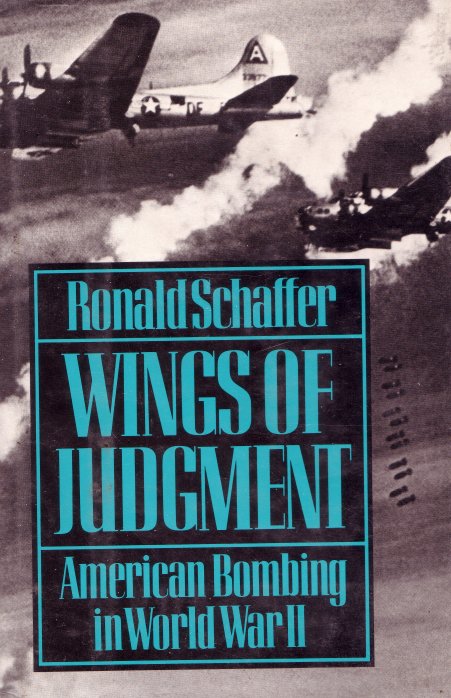
Wings of Judgment: American Bombing in World War II (1985)

The idea of dropping bombs on civilians was not something thought of just before the attacks on Japan. The Air War Plans Division was considering this type of thing in the summer of 1941, before the war even started.
The idea was to drop bombs on the German people, causing their morale to start to crack, and then drop even more bombs on the German people to lower civilian morale.
According to some of the war philosophies being considered at the time, “...in modern total war, civilians and armed forces were inseparably linked in national war machines.” In other words, killing soldiers and killing civilians was pretty much the same thing, as far as this philosophy went.
The M-69 incendiary bomb, the one used on Japan so successfully, was developed by Standard Oil.
In what was, at least to me, a surprise, the main advocates of incendiary bombing was not the military nor the scientists. It was insurance agents, who had a very good idea of damage caused by fire and what would be possible in bombing civilian homes.
From early on the idea was to get so many fires going that no fire-fighting effort would be able to put out the blazes.
The purposes of the incendiary raids were multifold:
1. Destroy the houses of the workers surrounding any factories.
2. Reduce the output of Japanese heavy industry.
3. Destroy food and clothing.
4. Interrupt public services needed for production.
5. Dislocate factory workers, and cause them to spend time in repair and relocation rather than factory production.
A Joint Incendiary Committee was established in June of 1944.
The committee was to consider what it would take to burn down six Japanese cities – Tokyo, Yokahama, Kawasaki, Nagoya, Osaka and Kobe. They also needed to figure out what would be the economic and military consequences of the destruction of those cities. The number to be killed was estimated at 584,000 people.
The Japanese, meanwhile, decided in October of 1943 to begin evacuating people from urban areas who did not work in the factories. As for Tokyo itself, 1.7 million people were evacuated by march of 1945.
In the main attack on Tokyo, the B-29s were opposed by 74 Japanese fighters, but they did no damage to the superfortresses. Two planes were brought down by anti-aircraft fire and another 42 damaged.
18% of the industrial area was burned out, and 63% of the commercial district was destroyed. Virtually the entire working-class residential zone was destroyed.
The attack made sure there was no gas, water, electric power or public transportation for days afterwards.
There was even a plan to try to bomb in such a way that poor people would be attacked but districts with rich people wouldn't, so there might be a class uprising of some sort. (Course, most of the poor people probably were killed, which doesn't leave a whole lot of room for a class uprising.)
The book also addresses the “home factories” issue. This was the concept that, dropping incendiaries or the atomic bomb and destroying homes was really destroying the war effort since the homes produced things needed for the war. The book says that this was no longer so, since “...American attacks on transporation had shut off their supplies and made it impossible to ship what they produced.”
”Having eliminated most targets of military and economic significance, the AAF moved increasingly into political and psychological warfare.”
They way this was done is that American planes would drop leaflets with a list of Japanese cities and say that a certain number of them would be destroyed the next day (or so), and then it would destroy the cities, then drop another set of leaflets, and so on. The idea was, I think, to make the Japanese feel totally helpless against the might of American bombing.
(What all of this did was to kill lots and lots and lots of civilians, but it didn't kill the army units that Japan had in reserve in case their home islands were actually invaded.)
Apparently Curtis LeMay, the guy who spearheaded the incendiary bombing attacks, said that it wasn't any more wicked to kill people with an atomic bomb than with rocks. (Although how many rocks it would take to be dropped at one time to equal the number of people killed by one bomb is a question I doubt anyone ever asked him.)
Apparently he also felt that the system of air command absolved officers from moral responsibility in relation to nuclear bombing.
A number of military men wanted revenge against the Japanese for atrocities they committed, such as the Bataan Death March, where wounded and sick American and Filipino men were bayoneted to death when they couldn't keep up. There was also Unit 731 and the terrible experiments they did on people in the name of biological warfare, the mass murder of Filipinio boys and the raping of women by a retreating Japanese unit, and the murder of American flyers downed over Japan.
Main Index
Japan main page
Japanese-American Internment Camps index page
Japan and World War II index page
|